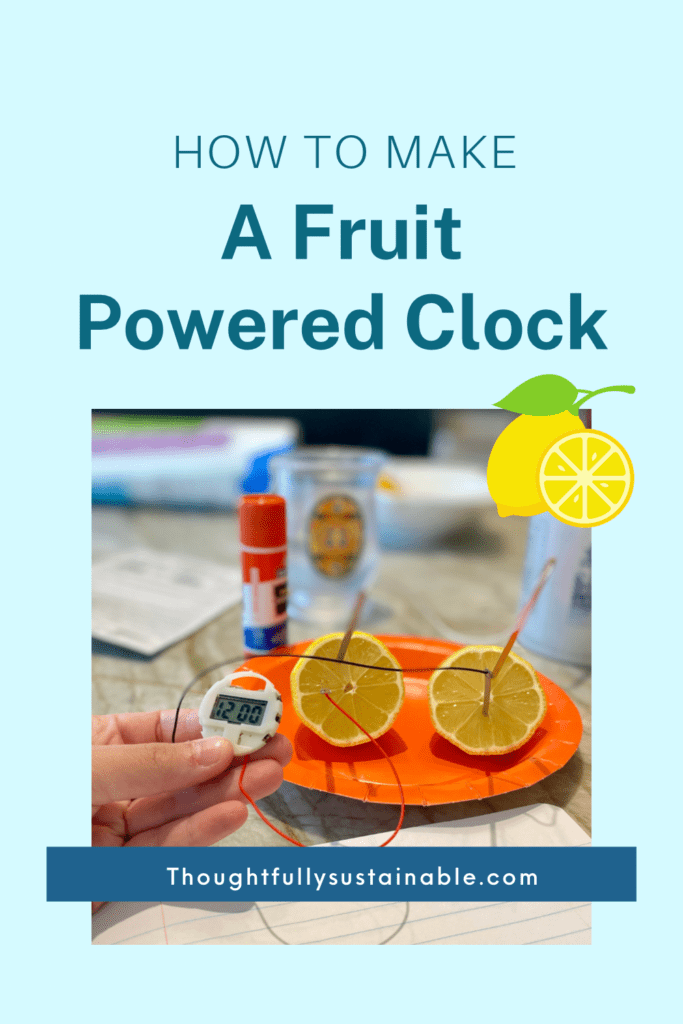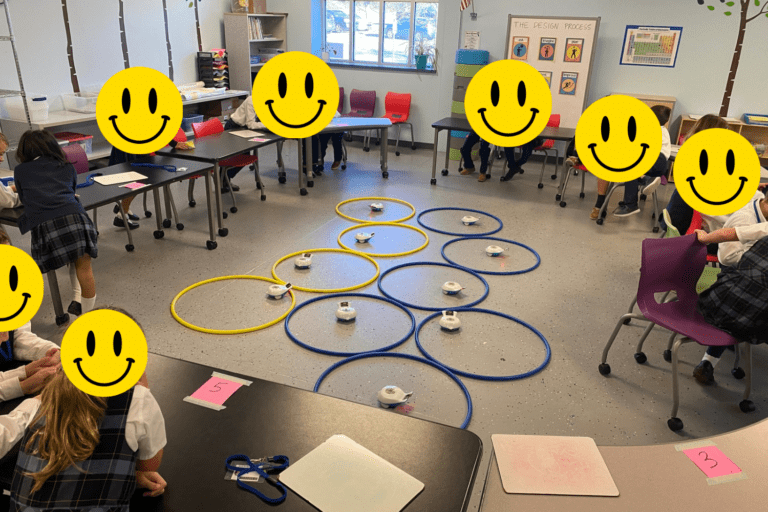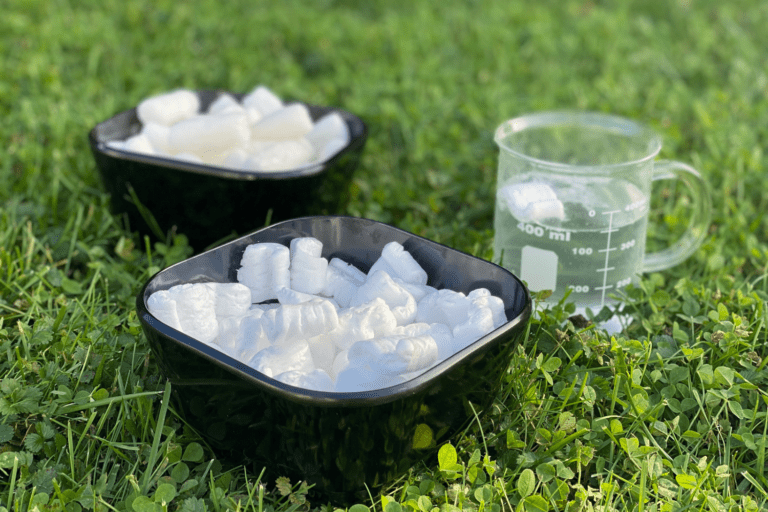How to Make a Fruit Powered Clock + FREE Printables
Have you ever thought of using your uneaten citrus fruit as an electrical power source? Introduce kids to electricity and alternative energy sources with this fun and simple science demonstration that explains how to make a fruit powered clock, along with free printable diagrams.
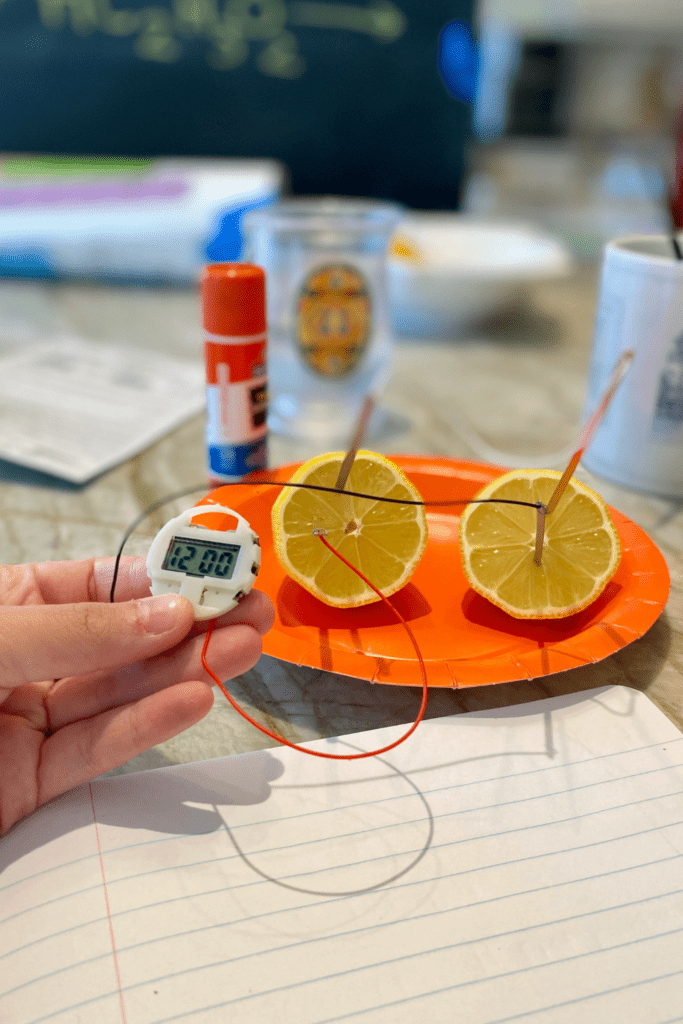
This post contains affiliate links. If you choose to purchase from the links provided, I thank you in advance for supporting my free educational content!
Are Fruit Powered Clocks Really a Thing?
Yes, they are!
As a former classroom teacher, I loved to watch my students’ expressions when they’d come to my office and see that my desk clock was powered by fruit! Their discovery would always start a conversation about how the clock worked and where they could buy their own. Occasionally the discussion led to alternative energy sources and creating fuel from food waste!
I’ve built a few of these in my years of teaching, and will walk you through the steps of how to make your own fruit powered clock, as well as the mistakes to avoid in order to make your clock building a success.
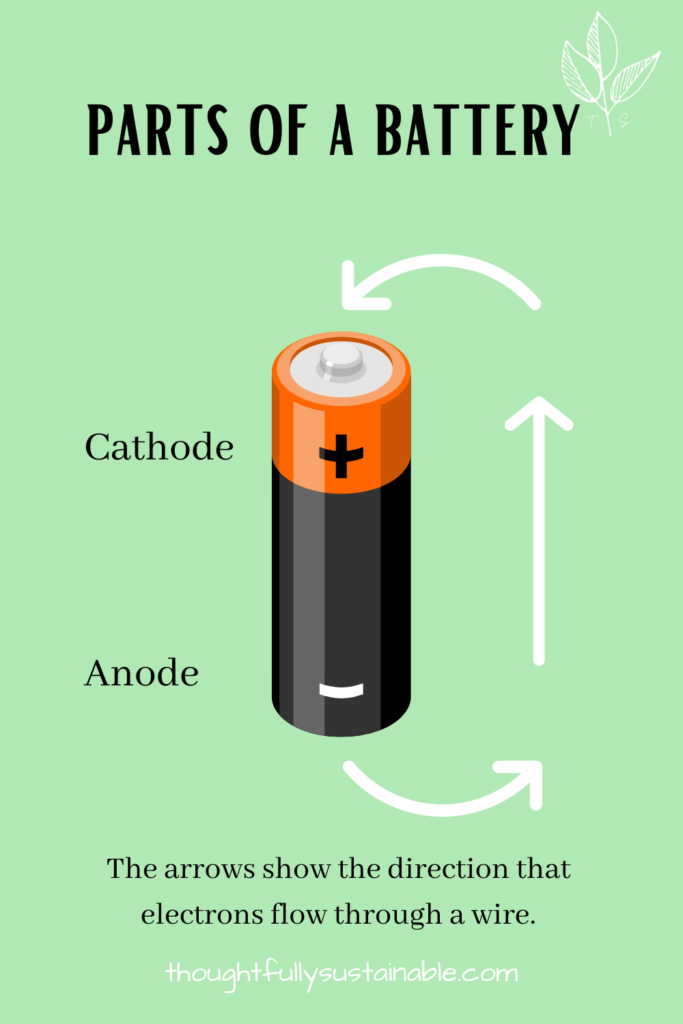
How Does a Fruit Powered Clock Work?
The best fruits to build a clock are citrus fruits. Oranges, lemons, limes and grapefruits are great candidates for clock building. The reasons citrus fruits work best is because they contain citric acid and acids are excellent at conducting electricity! Traditional batteries contain sulfuric acid which works the same way.
The citric acid is classified as an electrolyte, which means it can carry an electric charge when a bunch of electrons are thrown at it.
Where do the bunch of electrons come from?
They enter the fruit through the metal electrodes that are inserted in them. For our example the metals are Zinc (Zn) and Copper (Cu). Both of these metals are great givers of electrons, due to their atomic structure.
When the electrons from these metals meet the citric acid, a chemical reaction known as decomposition occurs, which breaks apart the acidic compounds into positive and negative ions. This ion “soup” creates an excellent pathway for electrons to flow from one metal electrode to the other, hence the positive (+) and negative (-) ends labelled on a traditional battery! This flow of electrons is what we commonly call electricity, and is what can power the simple digital clock shown.
If someone asks you what part of the fruit powers the clock, the short answer is citric acid.
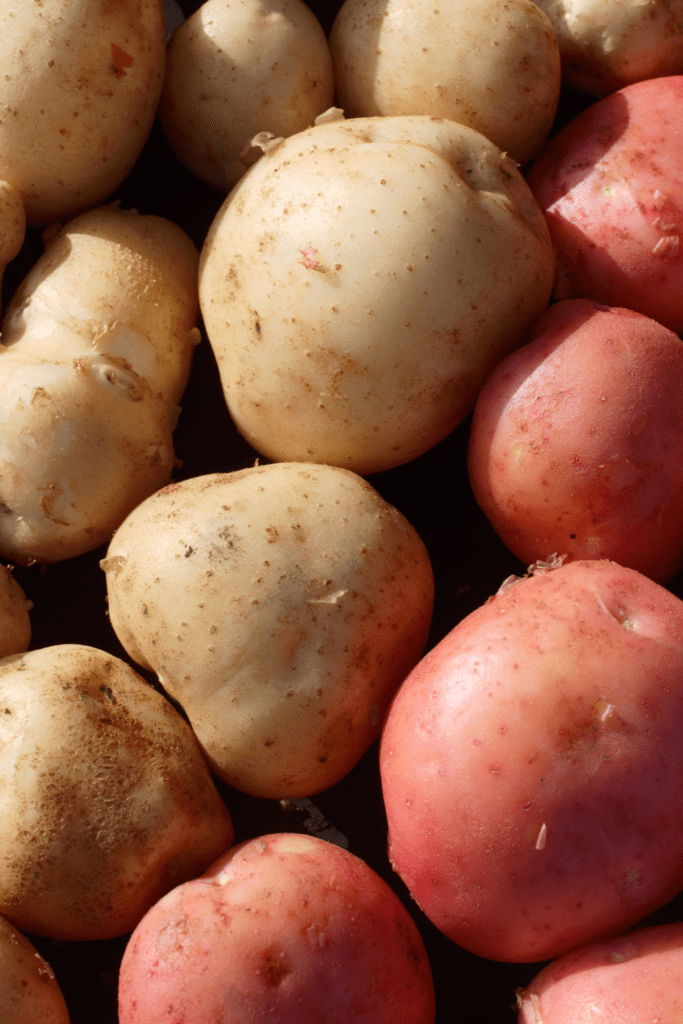
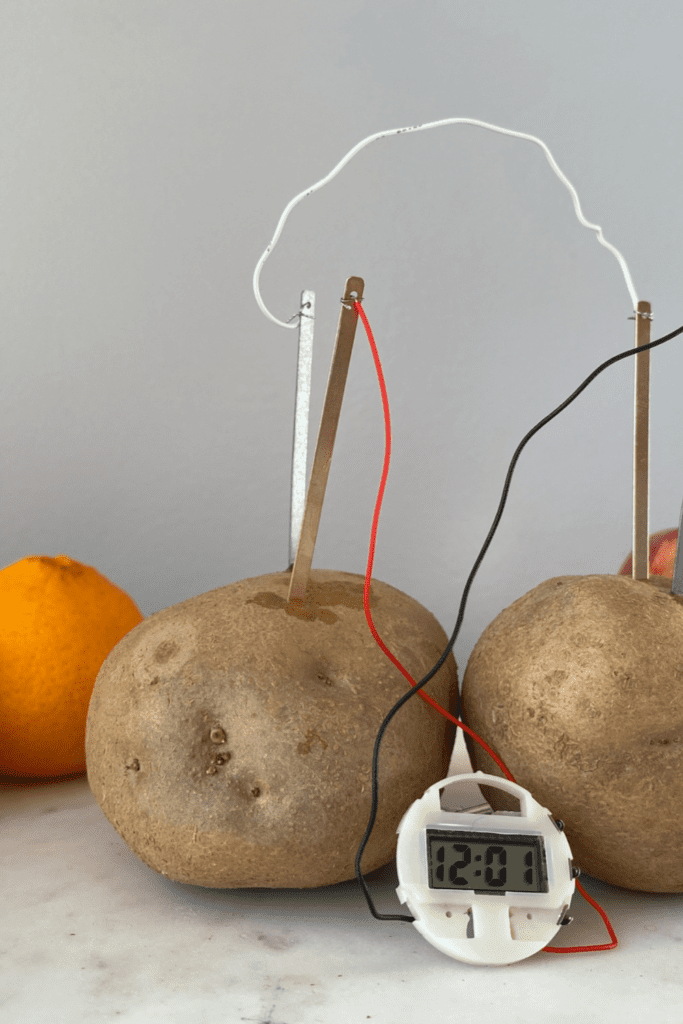
Do Potato Clocks Work Similarly to Fruit Clocks?
You may have seen clocks similar to fruit powered clocks that were made of ouf potatoes. The science is very similar. Potatoes are mildly acidic, containing small percentages of citric, malic, tartaric, oxalic, fumaric and succinic acids. The presence of these acids make them good conductors of electricity. Try substituing a potato for a citrus fruit in the clock tutorial to see for yourself! Running a side-by-side experimental comparison of the power of a potato versus a citrus fruit could be an excellent way to engage student learning.

Where Can You Buy a Fruit Powered Clock?
The best fruit powered clock option I’ve found is from 4M Kidz Lab Lemon Powered Clock. It’s simple and easy to use, and at the time of writing this, was listed at $7.99 per set-up.
How Does the 4M Kidz Lab Lemon Powered Clock Work?
In the 4M Kidz Lab Lemon Powered Clock Kit that I purchased online, I received a small LCD watch with red and black wires, two copper plates, two zinc plates, and a white wire. To make the clock work, follow these simple instructions:
- Connect the red wire on the LCD watch to one copper plate by inserting the wire through the hole at the top of the metal plate and bending the wire around it.
- Connect the black wire on the LCD watch to one zinc plate by inserting the wire through the hole at the top of the metal plate and bending the wire around it.
- Connect the white wire to the tops of the other copper and zinc plates.
- Slice a lemon in half.
- Pick up the copper and zinc plates attached to the white wire and insert the copper plate into one slice of lemon and the zinc plate into the other slice of lemon.
- Pick up the LCD watch and insert the zinc plate with black wire into the lemon slice with the copper plate.
- Insert the copper plate with the red wire into the lemon slice with the zinc plate and white wire.
- You should see the LCD screen begin to blink.
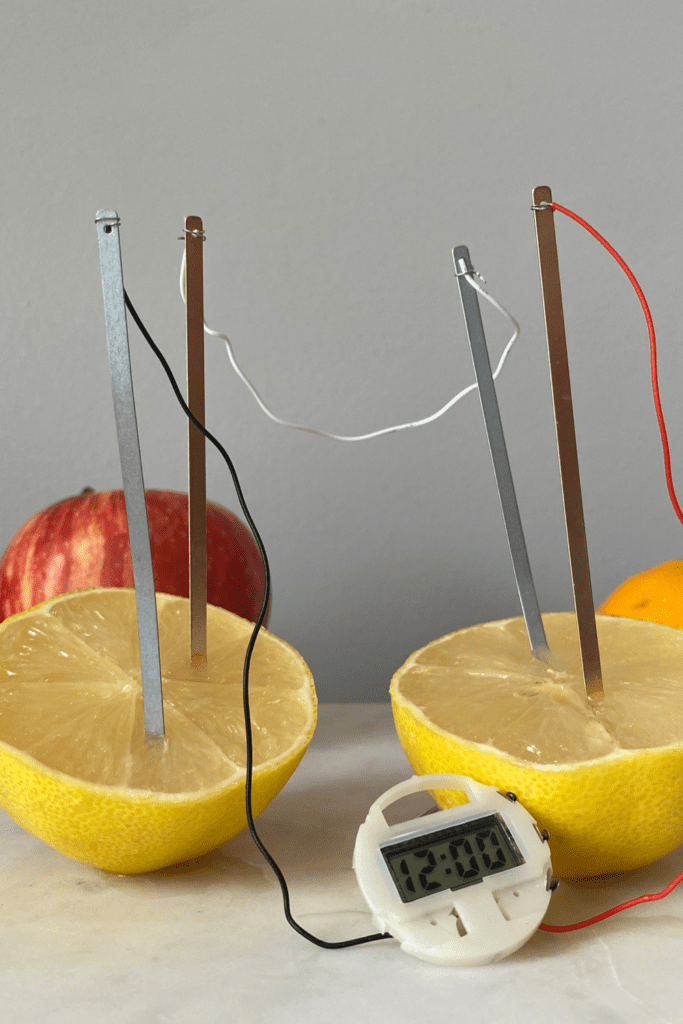
Understanding the Science Behind the 4M Kidz Lab Lemon Powered Clock
Here is an explanation of the science behind the 4M Kidz Lab Lemon Powered Clock, as stated on the back of the packaging of the kit
“The copper plates act like the positive electrodes of a battery. They are plated with a metal which is less reactive than zinc. When the plates are inserted into the lemon, a chemical reaction occurs. Electrons move from the zinc plates to the copper plates to form a current, thus activating the LCD watch. The lemon juice helps conduct electricity. You can replace the lemon with a potato, a grapefruit or use soft drinks and see what effect they have.”
I really like how simple and effective this kit is, and highly recommend it to anyone interested in learning about how a battery works.
Video Tutorial to Make Your Own Fruit-Powered Clock
Here is a step-by-step video tutorial to walk your learners through the process of building your own fruit-powered clock using a 4M Kidz Lab Lemon Powered Clock kit. If you find this video helpful, I’d greatly appreciate if you gave it a thumbs up and subscribed to my YouTube channel!
FREE Fruit-Powered Clock Printables
Building fruit-powered clocks can be a lot of fun for your learners. I’ve created some free printables to help them visualize the process to make the learning even more memorable.
My kids were enamored with “checking the time on the orange” but were surprised when, after a few days, the digital readout began to fade. The power of the fruit is dependent upon its freshness. After about a week, you’ll need to replace it and use the original one for a dried winter garland or chuck it in the compost.
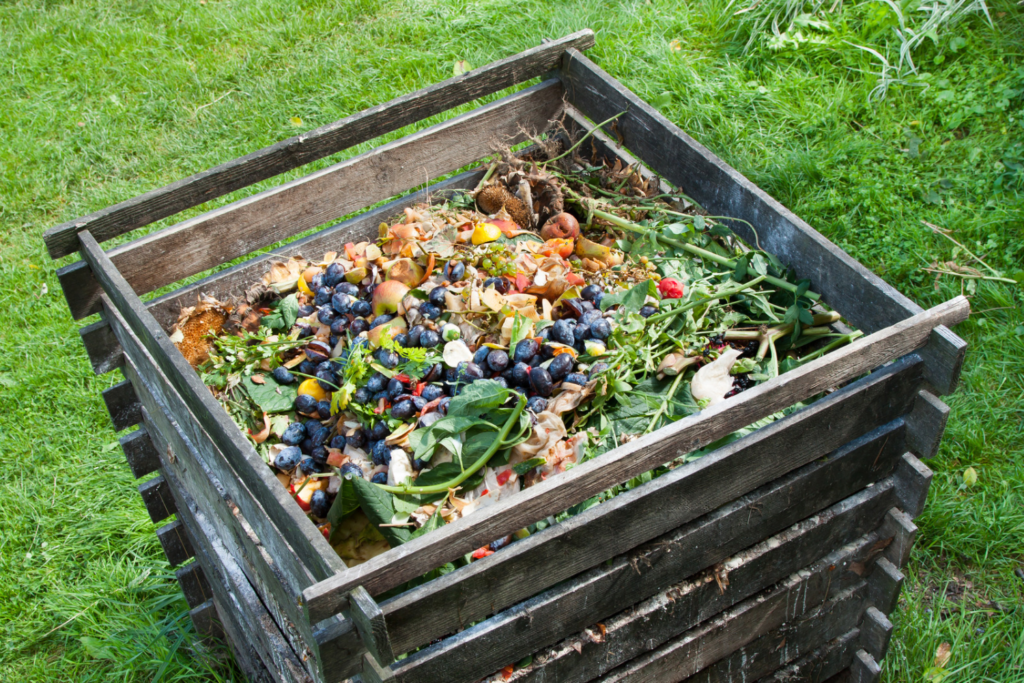
Repurpose Fruit to Avoid Food Waste
Builiding a fruit powered clock is a fantastic way to introduce a lesson on electricity. Its also a wonderful way to repurpose fruit that may be past its prime. Gather old lemons, limes and oranges from the cafeteria or quick-sale shelf of the grocery store and turn them into electricity generators! You can extend student learning by experimenting to see how long a particular citrus fruit can power the clock, then compare the results to other fruits. Just be sure to compost the fruits when you’re done with them to avoid their anaerobic breakdown in a landfill, which leads to the production of greenhouse gases like carbon dioxide and methane.
Discussing Alternative Energy Sources
Obviously, we can’t power our houses on citrus fruits, but what alternatives to pollution-emitting fossil fuels can we use?
This is a question you can ask your learners as an extension to this activity. Depending on their ages, you can have them create a list, either verbally or in writing, of all the different types of alternative energy sources they know of, such as solar, wind, water, geothermal and biomass.

Additional Resources on Renewable Energy Sources
Here are some additional resources you may find informative:
- How Does Wind Energy Work?
- Solar Energy Exploration
- Exploring Alternative Energy Sources
- Renewable Energy
- Kids for Renewables
I hope you’ve found this information helpful! If you’d like science lessons and activities like these delivered directly to your inbox, complete with free printables, subscribe to my newsletter below!
